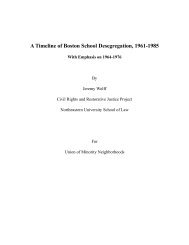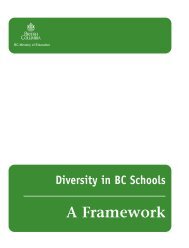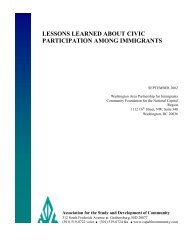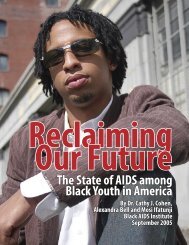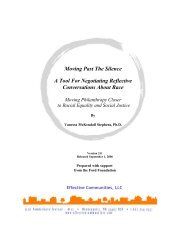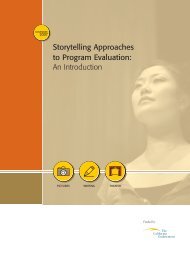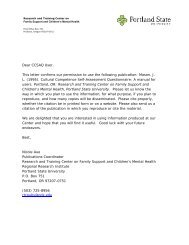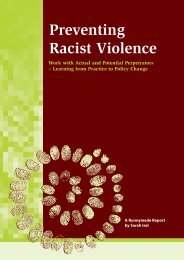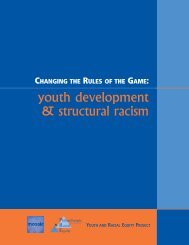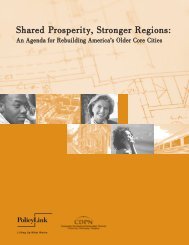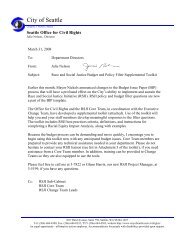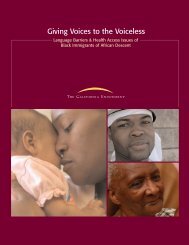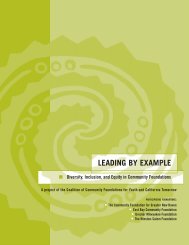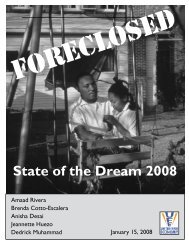EQUITABLE PUBLIC INVESTMENTis MDRC (formerly known as ManpowerDemonstration Research Corporation).The Re<strong>in</strong>vestment Fund performed a market analysis<strong>of</strong> Camden’s neighborhoods, categoriz<strong>in</strong>g eachaccord<strong>in</strong>g to the follow<strong>in</strong>g cont<strong>in</strong>uum: High Value;Strong Value; Steady; Transitional; Distressed PublicMarket; Reclamation. The analysis characterizedevery Camden neighborhood as Transitional,Distressed Public Market, or Reclamation. That is,no Camden neighborhood could be characterizedeven as Steady. Thus, TRF concluded that recreat<strong>in</strong>gCamden’s hous<strong>in</strong>g market was a necessary first steptoward address<strong>in</strong>g the structural deficits <strong>in</strong> citygovernment revenues. Focus<strong>in</strong>g on exist<strong>in</strong>g assets,TRF identified three neighborhoods with the bestchance for mixed-<strong>in</strong>come hous<strong>in</strong>g development.These neighborhoods—Parkside, EastCamden/Cramer Hill, <strong>and</strong> DowntownCamden/Lann<strong>in</strong>g Square—were selected becausethey were closest to exist<strong>in</strong>g stable markets. In thesethree neighborhoods, TRF anticipates that newmarket-rate hous<strong>in</strong>g, part <strong>of</strong> any mixed-<strong>in</strong>comedevelopment, would contribute new tax revenues <strong>and</strong><strong>in</strong>fluence broader revitalization efforts. Importantly,a clear dem<strong>and</strong> exists for a broader distribution <strong>of</strong>affordable hous<strong>in</strong>g, evidenced by a new mixed<strong>in</strong>comedevelopment <strong>in</strong> the Mt. Laurel, N.J., suburb<strong>of</strong> Camden, for which 30 percent <strong>of</strong> the applicantswere from Camden. Additionally, <strong>in</strong>itial <strong>in</strong>vestmentsare be<strong>in</strong>g made to explore regional workforcedevelopment programs focused on Camdenresidents, which also l<strong>in</strong>k to transportation <strong>and</strong>hous<strong>in</strong>g opportunities.Camden neighborhoods <strong>in</strong>clude both occupied <strong>and</strong> vacant row housesborder<strong>in</strong>g one another, just one <strong>of</strong> many examples <strong>of</strong> liv<strong>in</strong>g conditions <strong>in</strong>Camden, which has experienced a rapid decl<strong>in</strong>e <strong>in</strong> population, jobs, <strong>and</strong> quality<strong>of</strong> life. (© Camilo Jose Vergara, www.camden.rutgers.edu/~hfcy/<strong>in</strong>tro.html).In support <strong>of</strong> Camden’s f<strong>in</strong>ancial health <strong>and</strong> localcapacity development, TRF has partnered with theCRA to identify staff development needs, especiallythose relevant to spurr<strong>in</strong>g new developments <strong>in</strong> thethree target neighborhoods. The Ford Foundationhas made a grant to the National Association <strong>of</strong>Hous<strong>in</strong>g <strong>and</strong> Redevelopment Officials to plan <strong>and</strong>facilitate a series <strong>of</strong> workshops on organizationaldevelopment for the CRA. A vibrant, equitableregion requires stable, accessible <strong>in</strong>stitutions throughwhich people share <strong>in</strong> the region’s decisions <strong>and</strong>benefits. In support <strong>of</strong> efforts to build an<strong>in</strong>frastructure <strong>of</strong> leaders <strong>and</strong> civic organizations thatcan engage with ongo<strong>in</strong>g redevelopment efforts—<strong>and</strong> advance statewide policy reforms aroundtaxation, l<strong>and</strong> use, hous<strong>in</strong>g, transportation, <strong>and</strong> theenvironment—the Ford Foundation has funded onestatewide organiz<strong>in</strong>g <strong>in</strong>itiative <strong>and</strong> made grants tothree Camden-specific groups. The first is a grant tothe New Jersey <strong>Regional</strong> Coalition to implement astatewide organiz<strong>in</strong>g strategy focus<strong>in</strong>g on state publicpolicies that would advance regional equity. A grantto the Concerned Black Clergy (CBC) is forconven<strong>in</strong>g a dialogue <strong>in</strong> churches around issues <strong>of</strong>importance to Camden residents. Additionally, agrant to the Camden Churches Organized for People(CCOP) is for community organiz<strong>in</strong>g activities toensure citizen participation <strong>in</strong> the Camdenrevitalization process. Lastly, a grant to the Alliancefor the Revitalization <strong>of</strong> Camden City is to support acollaborative process to help build an effective civicorganization for Camden residents, <strong>of</strong>fer<strong>in</strong>g theopportunity to shape an agenda for the city’srevitalization. Furthermore, cross-program grantshave been made to other Camden nonpr<strong>of</strong>itsthrough the portfolios <strong>of</strong> other program <strong>of</strong>ficers <strong>in</strong>the Foundation’s Community <strong>and</strong> ResourceDevelopment Unit. These <strong>in</strong>clude grants to the local<strong>Regional</strong> Association <strong>of</strong> Grantmakers to sponsorregional equity programs <strong>and</strong> to organizationswork<strong>in</strong>g <strong>in</strong> education reform, open space <strong>and</strong>environmental justice, community/culturaldevelopment, <strong>and</strong> youth organiz<strong>in</strong>g.Through the work <strong>of</strong> MDRC, the critical activitiesundertaken to promote Camden’s economic revivalwill be documented <strong>and</strong> described. The <strong>in</strong>formationgathered will be used to <strong>in</strong>form ongo<strong>in</strong>gredevelopment activities <strong>and</strong> to equip public <strong>and</strong>private sector staff with “real-time” feedback.33Funders’ Network for Smart Growth <strong>and</strong> Livable Communities
Richmond, Calif.The second regional equity demonstration project is<strong>in</strong> Richmond, Calif. It is an area like Camden <strong>in</strong>many ways. A Bay Area suburb, its residents—predom<strong>in</strong>antly African American, Asian American,<strong>and</strong> Lat<strong>in</strong>o—sufferthe familiarRichmond is part <strong>of</strong> a challenges <strong>of</strong> racialdynamic, grow<strong>in</strong>g regional segregation <strong>and</strong>economic marketplace. For concentrated poverty.Richmond, the question There has beenbecomes whether somespeculation that thecity <strong>of</strong> Richmond<strong>of</strong> this regional growth cancould declarebe captured to exp<strong>and</strong>bankruptcy <strong>and</strong> jo<strong>in</strong>opportunities for low-<strong>in</strong>come Camden <strong>in</strong> a stateresidents <strong>and</strong> to advance receivership. Fromregional equity goals. the FordFoundation’sperspective, however,there is one critical difference: Richmond is part <strong>of</strong> adynamic, grow<strong>in</strong>g regional economic marketplace.For Richmond, the question becomes whether some<strong>of</strong> this regional growth can be captured to exp<strong>and</strong>opportunities for low-<strong>in</strong>come residents <strong>and</strong> toadvance regional equity goals.In 2003, Ford partnered with The San FranciscoFoundation to launch the Richmond demonstrationproject. An <strong>in</strong>itial, one-year, $450,000 grant wasgiven to The San Francisco Foundation. Some <strong>of</strong>this money was re-granted to three anchor groups:Urban Habitat, Contra Costa Faith Works!, <strong>and</strong> theRichmond Improvement Association. Therema<strong>in</strong>der was held by the Foundation to pay fortechnical assistance <strong>and</strong>/or consultants requested bythe three anchor groups, for their capacity build<strong>in</strong>gneeds, <strong>and</strong> to fund new partners identified as theproject evolved.The Richmond <strong>Regional</strong> Equity Demonstration hasvery different goals from the grants made underFord’s Camden <strong>in</strong>itiative. Dist<strong>in</strong>ct from Camden’sasset- or project-based regionalism, Richmond’semphasis is on community-based regionalism. InRichmond, the focus is on the grassroots<strong>in</strong>frastructure, support<strong>in</strong>g organized communitygroups <strong>and</strong> people as they identify their own needs<strong>and</strong> develop a stronger ability to address those needsat the regional level, through the concept <strong>of</strong> anEquitable Development Zone.Richmond, Calif., is a San Francisco Bay Area <strong>in</strong>ner-r<strong>in</strong>g suburb where theFord Foundation is engaged <strong>in</strong> a community-based regionalism demonstrationproject. Connect<strong>in</strong>g residents to a hot market region is one <strong>of</strong> the goals.(© Camilo Jose Vergara, www.camden.rutgers.edu/~hfcy/<strong>in</strong>tro.html).Accord<strong>in</strong>g to The San Francisco Foundation’senvironment program <strong>of</strong>ficer, Arlene Rodriguez, theEquitable Development Zone “def<strong>in</strong>es what thecommunity wants, <strong>in</strong> terms <strong>of</strong> hous<strong>in</strong>g, education,environment, transportation, <strong>and</strong> economicdevelopment, from any new <strong>in</strong>vestments <strong>in</strong> theirneighborhood.” This statement is echoed by MariaAlegria from ContraCosta Faith Works!:“The EquitableDevelopment Zone setsout the community’svision <strong>of</strong> what they wanttheir neighborhood tolook like <strong>and</strong> future<strong>in</strong>vestments <strong>in</strong>Richmond will beguided by this vision,deliver<strong>in</strong>g benefits forRichmond’s exist<strong>in</strong>gresidents.” Over time,the participants haveidentified a need foradditional expertise <strong>in</strong>order to best make <strong>in</strong>formed decisions. <strong>Regional</strong>dynamics <strong>and</strong> choices are complex <strong>and</strong> no one entityhas the <strong>in</strong>-house expertise for a comprehensiveapproach to decisionmak<strong>in</strong>g. Thus, as the projectevolves, resources have been devoted to br<strong>in</strong>g othertechnical service providers <strong>in</strong>to the process, mostly <strong>in</strong>the areas <strong>of</strong> hous<strong>in</strong>g <strong>and</strong> hous<strong>in</strong>g f<strong>in</strong>ance.Funder Interest“The Equitable DevelopmentZone sets out thecommunity’s vision <strong>of</strong>what they want theirneighborhood to look like<strong>and</strong> future <strong>in</strong>vestments <strong>in</strong>Richmond will be guided bythis vision, deliver<strong>in</strong>gbenefits for Richmond’sexist<strong>in</strong>g residents.”Through its Susta<strong>in</strong>able Metropolitan CommunitiesInitiative (SMCI), the Ford Foundation began an— Maria AlegriaEQUITABLE PUBLIC INVESTMENTPart III: Section 1: Promot<strong>in</strong>g Equitable Public Investment 34
- Page 1 and 2: Stories of Philanthropic Leadership
- Page 3 and 4: Signs of Promise:Stories of Philant
- Page 5 and 6: Funders’ Network for Smart Growth
- Page 7 and 8: (II. B.)(II. C.)Turning Neighborhoo
- Page 9 and 10: PART I:IntroductionThe Purpose of t
- Page 11 and 12: social justice issues as they relat
- Page 13 and 14: PART II:Perspectives on Advancing R
- Page 15 and 16: peer work, we can reestablish a sig
- Page 17 and 18: Annie E. Casey FoundationBaltimore,
- Page 19 and 20: neighborhoods into healthy ones—g
- Page 21 and 22: Charles and Helen Schwab Foundation
- Page 23 and 24: Section 1:Promoting Equitable Publi
- Page 25 and 26: I. A. BUILDING POWER AND GIVINGVOIC
- Page 27 and 28: policy advocates. In 2002, Milwauke
- Page 29 and 30: in Los Angeles, Ford’s Anthony no
- Page 31 and 32: I. B. PROMOTING COALITIONSTO ADVANC
- Page 33 and 34: Yet the interpersonal dynamics of c
- Page 35 and 36: guidelines. “Many of the member o
- Page 37 and 38: Funder InterestThe EPA supported th
- Page 39: I. D. DEMONSTRATING THESTRUGGLE FOR
- Page 43 and 44: through policy reform at the local
- Page 45 and 46: I. E. BUILDING COALITIONTHROUGH KNO
- Page 47 and 48: organizing project, the Connecticut
- Page 49 and 50: and businesses are quantified in a
- Page 51 and 52: I. G. REVITALIZING WHILEASSURING DI
- Page 53 and 54: In the late 1990s, the city of Albu
- Page 55 and 56: I. H. A TRAVEZ DE LA FRONTERA:LAND
- Page 57 and 58: The International Community Foundat
- Page 59 and 60: I. I. MOBILIZING ACTION FORREGIONAL
- Page 61 and 62: To meet all of these objectives, th
- Page 63 and 64: efforts. And with each public plann
- Page 65 and 66: pattern of disproportionate transpo
- Page 67 and 68: Clinica de la Raza identify this cr
- Page 69 and 70: Contact PeopleCarl AnthonyActing Di
- Page 71 and 72: Section 2:Making All Neighborhoods
- Page 73 and 74: II. A. REACHING BEYONDHOUSING TO IM
- Page 75 and 76: A local resident receives the keys
- Page 77 and 78: East Baltimore community and the Jo
- Page 79 and 80: example, adjacent to the EBDI area,
- Page 81 and 82: II. C. YIELDING REGIONALBENEFITS TH
- Page 83 and 84: is using transit-oriented developme
- Page 85 and 86: financing and innovative, forward-t
- Page 87 and 88: The Row House Community Development
- Page 89 and 90: II. E. COUNTERING THE PERFECTSTORM:
- Page 91 and 92:
funded community programs, includin
- Page 93 and 94:
housing developments and commercial
- Page 95 and 96:
owned enterprises, totaling $8.5 mi
- Page 97 and 98:
LOAN GUARANTEESSection 3:Connecting
- Page 99 and 100:
III. A. MAKING HOUSING ANOPPORTUNIT
- Page 101 and 102:
A new report from the National Hous
- Page 103 and 104:
The Straphangers Campaign was found
- Page 105 and 106:
Funder InterestThe Straphangers Cam
- Page 107 and 108:
or increase poverty. Whether direct
- Page 109 and 110:
The Regional Plan Association then
- Page 111 and 112:
multi-stakeholder effort composed o
- Page 113 and 114:
director with LISC. No one set of s
- Page 115 and 116:
12 western Louisville neighborhoods
- Page 117 and 118:
III. E. UNITING THREE STATESFOR ONE
- Page 119 and 120:
increased their personal wealth by
- Page 121 and 122:
summary evaluation of MSDI found th
- Page 123 and 124:
method alone was strong enough to m
- Page 125 and 126:
consistent body of work. The Counci
- Page 127 and 128:
3) Issues Need to be ConnectedThe f
- Page 129 and 130:
PART V:Glossary of TermsThe terms d
- Page 131 and 132:
Regional and neighborhood equity. A
- Page 133 and 134:
Tijuana River Reserve, California:h
- Page 135 and 136:
Sargent Shriver National Center on
- Page 137:
1500 San Remo Avenue • Suite 249



